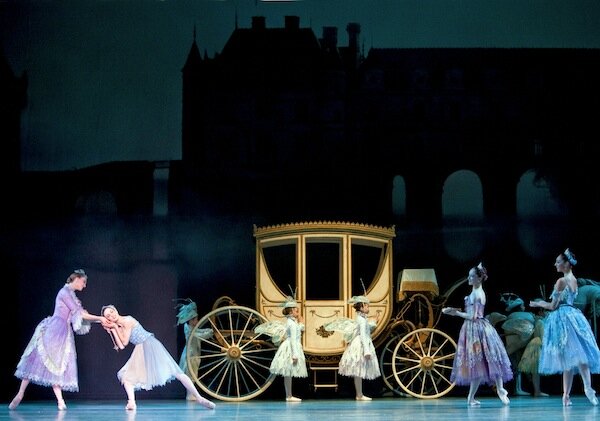 Pacific Northwest Ballet corps de ballet dancer Kylee Kitchens as Fairy Godmother and soloist Rachel Foster as Cinderella with PNB School students and Company dancers in Kent Stowell’s "Cinderella" (Photo © Angela Sterling)
Pacific Northwest Ballet corps de ballet dancer Kylee Kitchens as Fairy Godmother and soloist Rachel Foster as Cinderella with PNB School students and Company dancers in Kent Stowell’s "Cinderella" (Photo © Angela Sterling)
This is a ballet that draws adorable little moppets like nothing else. They may fade a little at an evening performance; I saw a few fathers heading out at second intermission with daughters deep in slumber over their shoulders. That's all right: They've seen the stepsisters carrying on, the carriage trip and ball's extravagant romance, by then.
Pacific Northwest Ballet's Cinderella (at McCaw Hall through Feb. 13) is like a hyper-elaborate dessert menu option, just slightly piquant, unfailing sweet, and technically impressive. Now, as a child-free curmudgeon, I don't really go in for this sort of thing, but it is actually a remarkable production. The combination of Martin Pakledinaz's glittering array of form-fitting, flowing, and wedding-cake-fantasy costumes, Tony Straiges' cinematic projections and gauzy scrims (plus the fairytale carriage), and Randall G. Chiarelli's warm-glow lighting pile on top of each other like layers of fruit and icing on a Prokofiev and Stowell cake.
If there's a weakness to Kent Stowell's on-the-bright-side telling, it's that nothing all that bad happens, people just like to dance. Cinderella has fond, beyond-a-scrim memories of her parents in former days to compensate for being ordered around like a servant, and she's so good-natured that even being skipped over for the ball doesn't really get her down. She's still playful with her stepsisters.
The dramatic stakes are just not very high--and as if to get downplay that by searching out extremes, Stowell's choreography gives some scene-stealing dancing to characters who have little dramatic reason for being (coughs, looks at jester), and explodes your head with the cute of little bug/fairy kids and clock/pumpkin children dancing like the most sincere pumpkin patch ever come to life. The little ones have real choreography to perform, and their applause is well-earned....
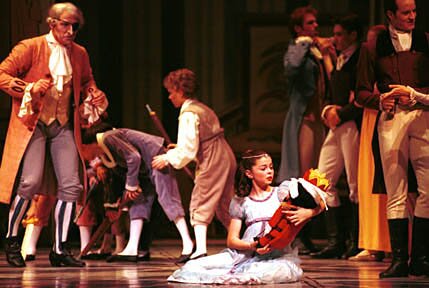 Pacific Northwest Ballet School student in "The Nutcracker" (Photo: © Angela Sterling)
Pacific Northwest Ballet School student in "The Nutcracker" (Photo: © Angela Sterling)
If you've been following The Nutcracker Chronicles, Alastair Macaulay's blog in the New York Times about his cross-country Nutracker-a-thon, you know that while the basics of the story remain largely the same from production to production, many ballet companies--large and small--employ artistic license to contextualize their Nutcracker for a local audience.
In the Nashville Ballet's production, young Clara goes to the 1897 Tennessee Centennial Exposition and her dreams take her to the land of sweets. In San Francisco, National Jewish Theatre Festival presented The MeshugaNutcracker! with the traditional Tchaikovsky music played in a klezmer style. The Tucson Regional Ballet's version is set in Tucson in the 1880's and features a battle between the coyotes and the U.S. Calvary.
With this in mind, I was wondering at last Friday night's performance what the Stowell/Sendak Nutcracker says about Seattle. I'd argue that it's: "Sure, we like our land of sweets, but it shouldn't be all fun and games, ya know." Maybe it's our Scandinavian heritage....
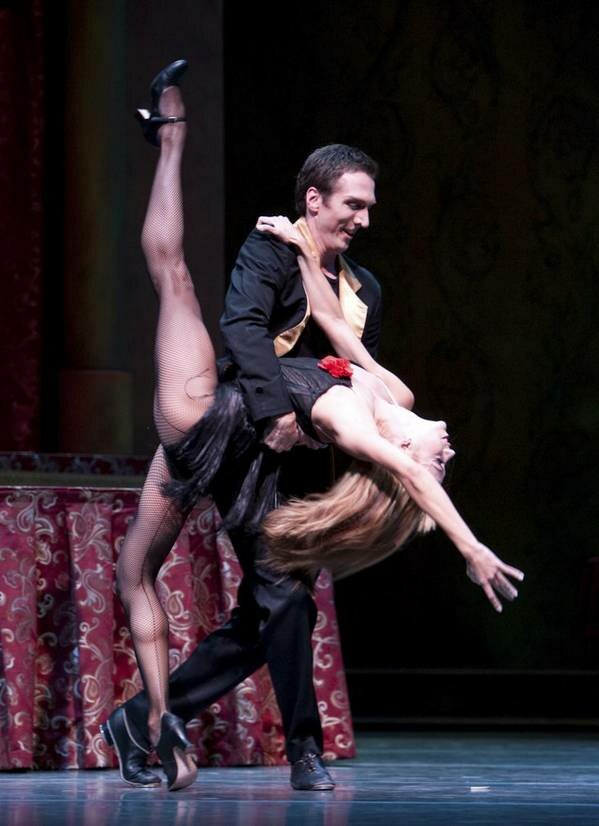 Pacific Northwest Ballet principal dancers Lesley Rausch and Jeffrey Stanton in George Balanchine's Slaughter on Tenth Avenue (Photo: ©Angela Sterling)
Pacific Northwest Ballet principal dancers Lesley Rausch and Jeffrey Stanton in George Balanchine's Slaughter on Tenth Avenue (Photo: ©Angela Sterling)
Pacific Northwest Ballet has just sent out a news release announcing that principal Jeffrey Stanton will retire after the 2010-11 season. He will have danced with PNB for 17 years, after coming to Seattle from San Francisco Ballet.
"I can now retire from my professional ballet career knowing that I gave it everything I had," says Stanton. Peter Boal remembers in particular one performance that Stanton did just that: "Jeff is perhaps the best hoofer I have ever seen in Slaughter on Tenth Avenue. During one of his triumphant performances in this role he suffered a severe sprain of his ankle. Sitting in the audience, I never knew. Jeff continued to dance with all of the charm and swagger that the role required. Audiences would never have guessed that Jeff left the theater that night in a wheelchair."
Read the full release after the jump:...
 Pacific Northwest Ballet principal dancers Karel Cruz and Carla Körbes in Twyla Tharp’s Waterbaby Bagatelles, presented as part of ALL THARP, Nov. 5-14, 2010. Photo © Angela Sterling
Pacific Northwest Ballet principal dancers Karel Cruz and Carla Körbes in Twyla Tharp’s Waterbaby Bagatelles, presented as part of ALL THARP, Nov. 5-14, 2010. Photo © Angela Sterling
"Cruz lifts Körbes, and then she pivots on his hands, as if about to launch herself forward into the water, and you desperately wish you could rewind that again and again," is what I wrote in my review of PNB's "All Tharp" over the weekend. So PNB's Gary Tucker did the next best thing, and sent five photos of the moment along. Click on the photo to be able to choose a larger version, but either way take a moment to let the inventiveness of Tharp's choreography embed itself in your brain. I don't know that there are any studies proving you'll be more creative as a result, but it can't hurt.
An evening with Twyla Tharp is worth making plans for, even if it's a vicarious accompaniment, through the medium of her dance works.
The three pieces on Pacific Northwest Ballet's "All Tharp" program (ends November 14) this time are Opus 111, Afternoon Ball, and Waterbaby Bagatelles, and it feels a bit like dinner date that begins with a walk through an autumn forest declaiming Keats, includes dinner at a dangerously chic nightspot with a window-view of the street, and ends with flipping through candid snaps of an Olympics swim team clowning and flirting in between meets.
Depending on which night you go, there's a special treat for PNB fans, given her impending departure at the end of the season, to see Ariana Lallone in one or more pieces.
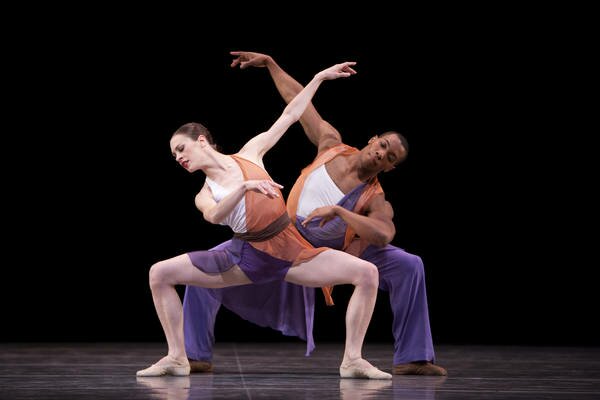 Pacific Northwest Ballet soloist Rachel Foster and corps de ballet dancer Kiyon Gaines in Twyla Tharp’s Opus 111, presented as part of ALL THARP, Nov. 5-14, 2010. Photo © Angela Sterling
Pacific Northwest Ballet soloist Rachel Foster and corps de ballet dancer Kiyon Gaines in Twyla Tharp’s Opus 111, presented as part of ALL THARP, Nov. 5-14, 2010. Photo © Angela Sterling
Brahms' String Quintet underpins Opus 111, and PNB gives you a live quintet (two violins, two violas, and cello) to enjoy. It's four movements, and you see five couples--everyone has their favorites, I'm sure, but for me the kinetic Batkhurel Bold and Carla Körbes stood out, along with a smoldering Ariana Lallone and Karel Cruz--though Tharp's mind seems equally focused on the overall picture: sides of the stage mirror each others' moves, or a movement series ripples its way through a diagonal line. I always wonder how much when you see a dance affects what you see, but something about Mark Zappone's costumes, fluttering swaths of color, made me think of the unpredictable way leaves twirl, coming down. And in any event, the dancers pirouette and spin throughout the piece, their arms almost always in motion, shoulders shrugging or pointing. They're frequently raised in a rounded "V" that near the end, when a more heel-and-toe folk-dance style arrives, becomes that fuller goblet shape you know from Russian dances, a pronouncement of hale-and-heartiness you can't help but be warmed by....
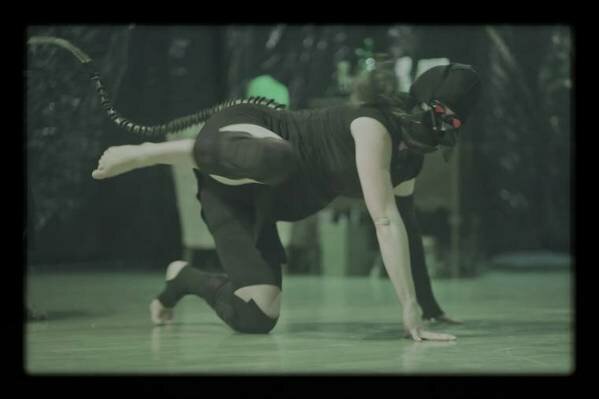 PB_TMOG's "Ayudapii: The Primitive (The Evolution of Need: Phase 1)". Photo by Tim Summers
PB_TMOG's "Ayudapii: The Primitive (The Evolution of Need: Phase 1)". Photo by Tim Summers
First up in this week's listings is Paige Barnes and Christopher Hydinger's Ayudapii: The Primitive (The Evolution of Need: Phase One) at Open Flight Studio (tickets $6-$14). That's a hell of a name, and the website's description can be equally oblique, but then again, this is dance: it's a physical language that doesn't lend itself so well to verbal description, making me think that the old phrase would be more appropriate if restated as: "Writing about dance is like music about architecture." Except that actually sounds pretty cool, and I think it's been done, thus disproving the sentiment. But whatever. I digress.
If you want my sales pitch for why you should head to the U-District for this show, which runs for only two weekends, it's that dancer/choreographer Paige Barnes is working with some fascinating elements here and the result is really interesting. First of all, the name "ayudapii" is a word she made up to describe the movement style she's employing, which relies on an intense relationship with the floor and the space just above it. Now, that may sound sort of academic, but trust me: in execution, creating dynamic movement in such a small space is actually remarkable, particularly when you account for the fact that it's not particularly easy to move on or near the ground. I've seen some video of this and it's impressive.
Partially that's owed to Barnes' company of dancers, which include a few of the people I frequently describe as dancers "whose work I've liked" or as "one of my favorite performers in town," but there's a reason for that, and Alice Gosti, Allie Hankins, and Monica Mata Gilliam all fit the bill. Finally, Hydinger (who performs as "The Music of Grayface") provides a haunting score, and the piece is visually stunning....
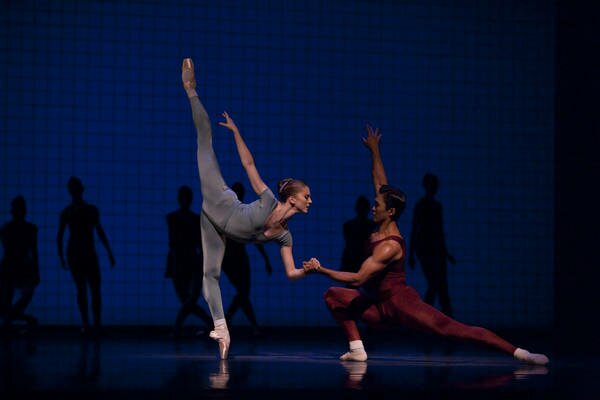 Pacific Northwest Ballet principal dancers Carla Körbes and Batkhurel Bold in Jerome Robbins’ Glass Pieces, presented as part of DIRECTOR’S CHOICE, Sept. 24 – Oct. 3, 2010. Photo © Angela Sterling
Pacific Northwest Ballet principal dancers Carla Körbes and Batkhurel Bold in Jerome Robbins’ Glass Pieces, presented as part of DIRECTOR’S CHOICE, Sept. 24 – Oct. 3, 2010. Photo © Angela Sterling
PNB's Director's Choice program has one more weekend to enthrall dance--not simply ballet--fans. Running through October 3 at McCaw Hall, it's post-Balanchine, but just barely: Three of the four pieces are from the mid-1980s.
My favorite of the evening was the finale, Glass Pieces, an against-type Jerome Robbins work that PNB's Peter Boal is personally acquainted with. Using a Philip Glass score, Robbins looks into the beehive of humanity. "Robbins wanted us to be frenzied pedestrians traversing Grand Central Terminal at rush hour," reports Boal in the program notes. The towering back wall is a gridwork that also suggest the ubiquitous tile of public spaces.
After the first movement's commute--threaded by three spare, elegant duets--a shadowed line of dancers processes slowly across the back of the stage, carrying the rhythm in their hips and knees, trading places, stepping sideways, as Glass's minimalist score also chugs its way past the fevered fingers of the orchestra.
In the second movement, Carla Körbes and Batkhurel Bold have a duet is almost purely musical shapes. It's minimalist dance--for a moment, they stand, arms lightly curving. There's a solidity and amplitude to Körbes and Bold, as if they'd been sculpted from living rock. For the third "act," Robbins has social machinery transmit the movements that gradually lead to a stage-filling ensemble, the initial regimentation blazing out in a furious complexity....
It's a PNB premiere, this Coppélia (through June 13), the latest in a line of Coppélia premieres that stretches back to 1870. (Balanchine's interpretation of Petipa's version had its premiere in 1974.) Pacific Northwest Ballet and San Francisco Ballet co-produced this one, with luxurious, fairytale scenery and costume design by Roberta Guidi di Bagno.
There's a little teapot of a house, a huge, leafy canopy that stretches the width of the stage, and a book-and-mechanical-doll-strewn workshop where Dr. Coppelius (Peter Boal) is working on his dream of a lifelike young woman. Totally not creepy, I'm sure. Be prepared for everyone to clap each time the curtain goes up. The set and costumes are of a piece with the sweetly light-hearted score from Léo Delibes (conducted with monochromatic bounce by Nathan Fifield on opening night).
In theory, Coppélia is a story ballet, though I have a suspicion that if you plotted it out minute by minute, you'd find that dance advancing the narrative made up about forty percent of the total. The rest is Balanchine amusing himself--and the audience--with dancing around this parable....
I haven't read that he was socked in the jaw very often, but I have to think that in dancers' dreams at least, George Balanchine was as much abused as adored.
I'm thinking of the moment in Serenade when Ariana Lallone pivots en pointe, one leg languorously outstretched, as a male dancer kneels behind her and, unseen, ever so slowly rotates her. Lallone's face is a perfect mask, her wrists, her fingers, not too tense, she's a living sculpture--and her body's weight shoots down through a single trembling, balancing ankle to a toe shoe.
My ankle sprained in sympathy.
PNB's "All Balanchine" (through April 25) may be the strongest of their celebrations of the celebrated choreographer's work that I've seen. The program of Serenade, Square Dance, and The Four Temperaments shows off Balanchine's remarkable ability to marry that Balanchine aesthetic to music. In each case, it's not a shotgun wedding, it's a love match. The audience on Saturday afternoon arrived head over heels, and applauded the curtain going up.
Serenade (from 1934) is a romantic vision set to Tchaikovsky's Serenade for Strings, the stage loaded with ballerinas in long tutus. When it was new, audiences reacted to it the way PNB audiences respond to William Forsythe. At one point, heedless of symmetry, Balanchine has everyone crowd into the far corner of the stage and crouch, while a soloist performs downstage. Oh, the humanity!
If there's a trained expectation he doesn't leave unsatisfied, I'm not sure what it is. Instead, there are chords of dancers, patterns and intersections drawn from the music, and contrasts between steps and rhythm. A few themes cut across each piece: Balanchine's regard for stillness, the way he uses it as a dash rather than a period at the end of a series. Those challenging one-legged landings from a leap. Extension that, even flat-footed, creates a sense of elevation....
There's a fake wholesomeness to classical performing arts that I've never quite understood. I've seen it at the opera, when older patrons complained about how a director "spoiled" a pretty aria by dramatizing the rape or murder that goes along with it. Similarly, all parents subscribe to the right to drag little girls in tutus to ballet, without glancing at the program--trained, perhaps, by ballet's preference for the romances of Barbies & Kens. But this cheats the childless, for one, and parents themselves, for another, of the chance to deal with adult emotions and situations.
Ulysses Dove's "Serious Pleasures" is not for kids. Not much about PNB's "3 by Dove" (through March 28) is. The suggested anal sex, fellatio, and masturbation aside, there's a keening sexual anguish that pervades the work. It assumes that you've been there, and done...that...and that...and that. Maybe not that, but you've heard about it. From the opening, when Lucien Postlewaite as the Narrator, hooked onto two bars on the wall, unwinds himself and his kinked imagination, there's space being made for an artistic perversity. The staging is by Parrish Maynard.
"No regrets, no retreats, no looking back," Dove once said, but "Serious Pleasures" is precisely that look back--in this case, to the '80s club scene, where as a sort of sexual Orpheus, the Narrator wanders among the shades of old passions and desires. (The '80s had that effect on people--see Whit Stillman's Last Days of Disco.) Louvered banks of dark gray doors burst or swing lazily open, revealing one tight, lithe body after another. Hair swirls in backlit cascades. Women pose as if in peep show booths. The music (Robert Ruggieri) is a pounding club beat. Men (Jordan Pacitti getting his satyr on) stot their way across the stage.
It's not, actually, to shock. Dove interpolates some Balanchine technique to further show off the body erotic, but it only emphasize the leaky libidinal boats we all sail in. As Freud noted, if it's not sex, it's death, and underpinning the spectacle in this underworld of statuesque desire is a remorseful knowledge that it's all already happened, already done. And the Narrator rewinds himself on the wall, restating Henry Miller's "rosy crucifixion."...
Classical ballet doesn't get more classical than The Sleeping Beauty, this production especially, which, as PNB's Doug Fullington explains it, has a lineage that extends right back to its original choreographer, Marius Petipa. When Kaori Nakamura, as Princess Aurora, balancing en pointe on a single foot, has each of her suitors turn her, hold, then release, four successive times, it's such an apotheosis of style that it's hard to believe a human ankle is involved. (PNB's production, running through February 14 at McCaw Hall, employs rotating casts, so your Princess Aurora may vary. Tickets are $25-$160.)
One of the humanizing qualities of such an idealized art form is that, even with notation, there's no better way to be sure of a choreographer's intent than seeing his work yourself. Ronald Hynd's wonderful version is just two choreographic generations from a 1921 Diaghilev production that toured to London, which gets you right back to St. Petersburg and Petipa.
Yet you don't think of The Sleeping Beauty as, narrative aside, slumbering unchanged for a hundred years. It exists, in Mircea Eliade's formulation, in illo tempore, in a once upon a time adjacent to the present. (On the other hand, this is a three-hour ballet with substantial action in pantomime, not a sing-along fairy tale, so while I can vouch for its immediacy, I can also vouch for the adorable little moppet behind me talking throughout, kicking seat backs, doing an impromptu dance break, beating time on an arm rest, and guzzling her way through a juice box.)
The Prologue presents the baby's christening, in a kingdom with access to yards of gold lamé--Peter Docherty's costumes start out storybook and trend towards Bedazzler--with seven fairies bearing gifts of beauty, temperament, beauty, and so on, each having a little solo. Sadly, Carabosse the wicked fairy was left off the invitations, and shows up enraged, promising deadly spindles on sixteenth birthdays, before the Lilac Fairy of Wisdom (Carla Körbes, last night) steps in to water down a death sentence into a coma....
The various contributors to "Break a Heart" at On the Boards. Photo by Tim Summers.
Not that plenty of interesting plays aren't opening this month (Glengarry Glen Ross at the Rep, Not a Genuine Black Man at Theatre off Jackson, and The Woman in Black at Open Circle, to name a few), but February is shaping up to be a particularly incredible month for dance in Seattle. With offerings ranging from a noted staging of a ballet classic at PNB to a world premiere by one of Seattle's up-and-coming performance groups, and a couple festival line-ups thrown in, this month presents a veritable cross-section of the best of what Seattle and the region has to offer.Sleeping Beauty at Pacific Northwest Ballet (Feb. 4-14; tickets $25-$160). A masterpiece of Romantic ballet, with a score by Tchaikovsky, PNB's production of Sleeping Beauty is based on British choreographer Ronald Hynd's painstaking 1993 reconstruction of Marius Petipa's 1890 original. I sat in on the dress rehearsal last night, and was wowed (along with a dozen or so starry-eyed little girls) by the sumptuous production and Princess Aurora's glorious movement.
Break a Heart at On the Boards (Feb. 11-14; tickets $18). A host of Seattle choreographic talent joins forces to present an evening of movement exploring love, which is of course set opposite Valentine's Day. Break a Heart features work by Wade Madsen, Crispin Spaeth, Diana Cardiff, Kristina Dillard, ilvs strauss/Jody Kuehner, Sara Jinks and Juliet Waller Pruzan/Stephen Hando....
Seattle Dance Project's "Project 3" opens tonight, January 29, and will have seven performances this weekend and next at ACT. Tickets are $25. Here is a conversation with choreographer Edwaard Liang, whose work is having its premiere.
Pacific Northwest Ballet was bustling with bunheads when I met up with Seattle Dance Project co-founder Julie Tobiason in a conference room there, before rehearsal started on Edwaard Liang's new work. It's their third season performing as part of ACT's Central Heating Lab, but they gather their rehearsal studio time while--and where--they may. Julie had her third baby with her--she's part of a maternity explosion that's hit the group, and is sitting this set of performances out.
Tell me about starting the group.
 SDP founders Tim Lynch and Julie Tobiason (Photo: Angela Sterling)
SDP founders Tim Lynch and Julie Tobiason (Photo: Angela Sterling)
For us, it was like now or never. We had this great group of dancers around, and if you're going to say, "I'm going to fundraise for the next three years..." You don't know who'll be around. You just don't know. We were awarded two grants, and so that's why we started when we did. It just felt like if we wait, it's not going to happen. We're grassroots, if we realize our budget is going to be $5,000 off, we look to see what we can cut. It so bare bones anyway, but that's what we're all doing.
We started in 2007, rehearsing and getting pieces going. Our debut was with "Project 1" in January 2008. In our second year we did "Project Orpheus" in the fall, and then January 2009 was "Project 2." This season we did a collaboration with the chamber music group Simple Measures in November '09. Our idea in building repertory is to have a mix of collaborative productions and our own self-produced repertory productions.
Is everyone from PNB?
We're PNB heavy, that's part of the reason why we started. When I left I did some work with Donald Byrd over at Spectrum, I did some work with Maureen Whiting; I wanted to explore other modern and contemporary works. The ballet career--forty weeks a year, thirty to forty hours a week--I had done that since I was sixteen years old. So I wanted to do some things I felt I was motivated to do.
Timothy Lynch had retired the year after me from PNB, and I knew he wanted to continue dancing. You know, retiring from PNB doesn't mean your dance career ends, unless you decide that. We were talking about Maureen's work, and how much we loved contemporary and new works, and other dancers--Alexandra Dixon, Oleg Gorboulev was here teaching and doing some guesting, and Dana Hanson. We just had a great group of people hanging around with similar interests, so that's why we started it, really. Kory [Perigo] and Betsy [Cooper], they're from modern dance, though they trained in ballet....
Special to The SunBreak by Scott Bernard.
Pacific Northwest Ballet’s production of The Nutcracker kicked off its 26th season last (Black) Friday night (it runs through December 30; tickets are $26 and up). The date was especially fitting, in that a successful Nutcracker production is to most ballet companies what successful holiday sales are to Nordstrom.
If you haven’t seen it, what makes this production different from others done in countless cities--and from the New York City Ballet/George Balanchine version televised on PBS this time of year--is its depth. With sets and costumes by Where the Wild Things Are author and illustrator Maurice Sendak, this production benefits from his tendency to embrace the darker side of childhood.
Napping on Christmas Eve, young Clara dreams of her godfather, Herr Drosselmeier, who conjures a valiant Nutcracker character to protect the lovely Princess Pirlipat from the evil Mouse King. That doesn’t go so well, the Nutcracker is defeated, and the Mouse King bites the Princess. Fail.
Later that evening at a Christmas party hosted by her parents, Clara receives the gift of a Nutcracker doll from the dysfunctional, eye-patch-sporting Drosselmeier. Her little brother Fritz is given a Mouse King doll, and doing what little brothers do when egged on by their bizarre godfathers, chases Clara, breaking the Nutcracker doll. Drosselmeier bandages the Nutcracker with his handkerchief, and dancing ensues. The guests slowly leave, but not before Dosselmeier whispers to Clara something that seriously creeps her out. (Where is Chris Hansen when you need him?)
When Clara gets out of bed at midnight to find her Nutcracker, she trips over and injures one of the little mice scurrying about. This ignites sectarian tensions between the mice and Nutcracker loyalists. Battle ensues, and the Nutcracker army wins (Mission Accomplished!) thanks to a shoe thrown by Clara. As a reward, the Nutcracker takes the suddenly adult Clara (sorry, Drosselmeier) to what looks to be one of Saddam’s palaces, where dancers from various countries perform for their viewing pleasure.
As young Clara, Eileen Kelly had the right presence and grace. Daniel Bryson-Deane was terrific as her little brother Fritz, bringing a genuine touch to the role without going over the top. As the adult Clara, Carla Körbes danced with technical precision, lyricism and feeling. Stanko Milov was a perfectly fine Nutcracker, although there wasn’t much chemistry between Körbes and Milov. Arianna Lallone danced the role of the Peacock in the way that only she can. (Hers are seriously tough pointe shoes to fill.) The excellent PNB corps was a bit out of sync in the snow scene at the end of Act One, but was tight for the Waltz of the Flowers, led by Mara Vinson....

Most Recent Comments